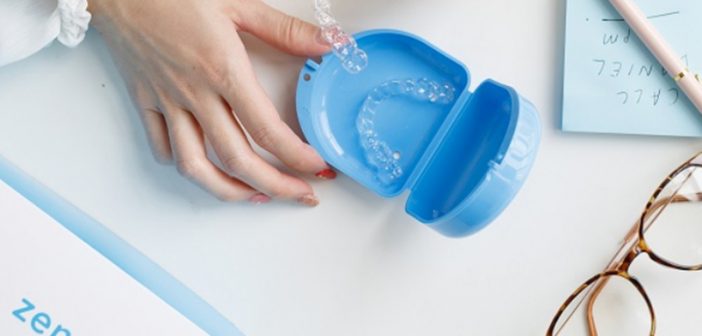As the adage goes, you are your worst critic. In my case, it is particularly true. And that was probably the primary motivation for me to undergo orthodontic treatment for the second time in my life. As if doing it once is not enough.
Born with a set of not-so-perfect teeth, I first went through the agony of wearing dental braces – the ugly metal type, at that – when I was 17. A couple of decades later, my once-straightened teeth become misaligned again, no thanks to my wisdom teeth that pushed against my other teeth.
I put up with crooked teeth all these years because, as ironic as it may sound, I am vain. Let’s face it – braces are ugly. I don’t really want to have a mouthful of metal brackets for at least a year or so again. Thankfully, orthodontic treatment has come a long way since the days of my youth. With invisible aligners, the idea of orthodontic treatment is now more attractive.
The Journey Begins
Invisible aligners used to be extremely expensive, starting at an eye-watering price tag of S$8,000, and was offered by only one or two major brands. However, with the entry of new players, invisible aligners are now at a more accessible price point and a fraction of what the major brands are charging. One such new player is Singapore start-up Zenyum.
Founded in 2018, Zenyum produces 3D-printed invisible braces. The company believe that “a confident smile should not cost a fortune” and offers its invisible braces up to 70 per cent cheaper than other invisible braces.
After I have gotten in touch with Zenyum, I was told to submit photos of my teeth from different angles for the initial assessment, which is free. Not everyone can be a suitable candidate for Zenyum, I was told. The team at Zenyum has to assess your teeth condition first. Those who have serious misaligned teeth will be more suited for metal braces rather than invisible aligners.
The First Physical Assessment
Shortly after submitting my photos, I was informed by Zenyum that I was a suitable candidate. Zenyum matched me with a dentist on their panel and an appointment was made with Dr Anna Beth Seow (currently with Tanglin Dental group).
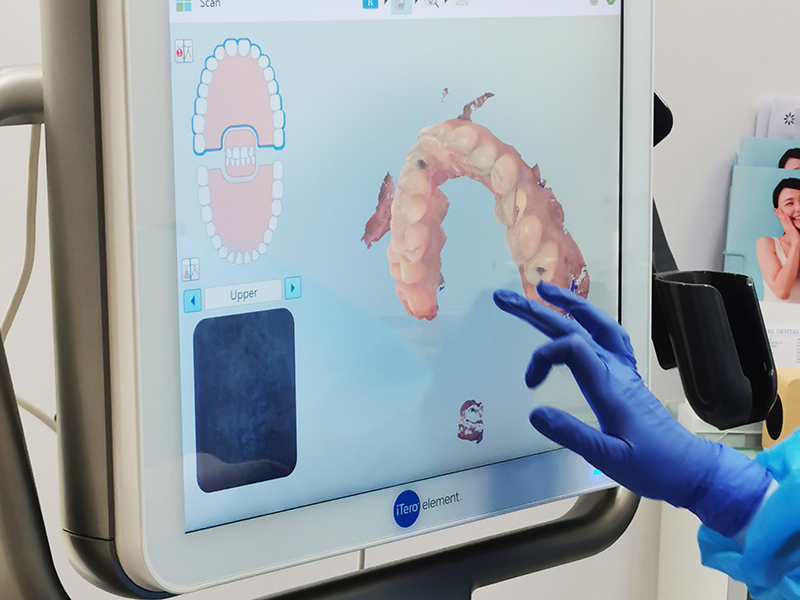
The 3D scan of my teeth.
At the clinic, Dr Seow physically assessed my teeth condition and also did a 3D scan of my teeth. There was also an X-ray done. All these were done to create a treatment plan for me. The entire process was relatively quick and easy.

I have an X-ray done on my first session with the dentist.
A couple of weeks after the visit, Zenyum contacted me on how my treatment plan would be like. They even provided a simulation of how my teeth would shift throughout the treatment and look eventually. Once I gave the OK, Zenyum proceeded to commence the production of my custom-made 3D-printed invisible aligners – a process that took about three weeks.
The First Fitting
When my aligners were ready for collection, I was called in for a second session with Dr Seow who guided me on how to wear my aligners. To make room for my teeth to shift, a few of my teeth had to be filed to create spaces. In contrast, one would have to extract healthy teeth for metal braces (I extracted four in the past).
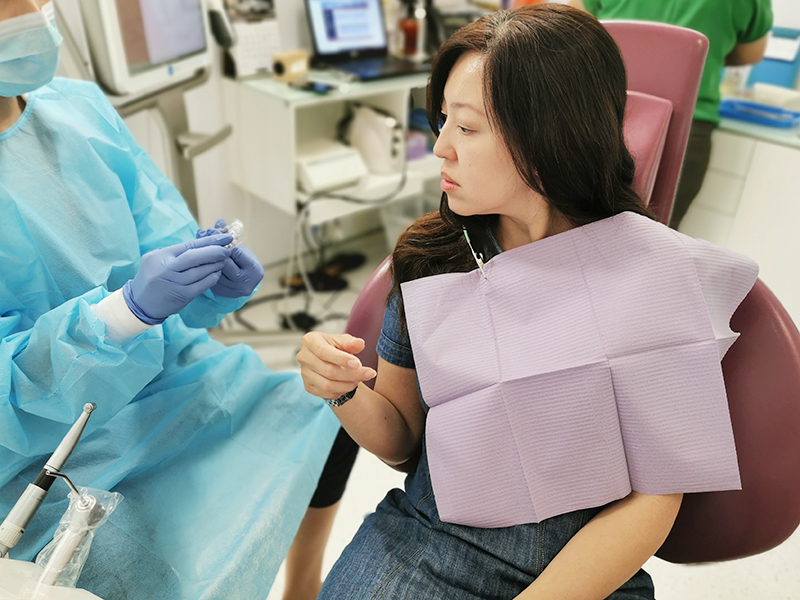
Dr Seow shows me how to care for and put on the new aligners.
I’ll be frank – I was uneasy about the new gaps in my teeth. In particular, my two front teeth were among those that were filed and so there was a new unsightly gap between my two front teeth. However, the moment I wore the aligners, the gap closed up.
The Road to Straightening My Teeth
The entire treatment duration varies from individual to individual. In my instance, I was informed that my treatment would take seven months (though it got extended subsequently, partly due to the nationwide lockdown).
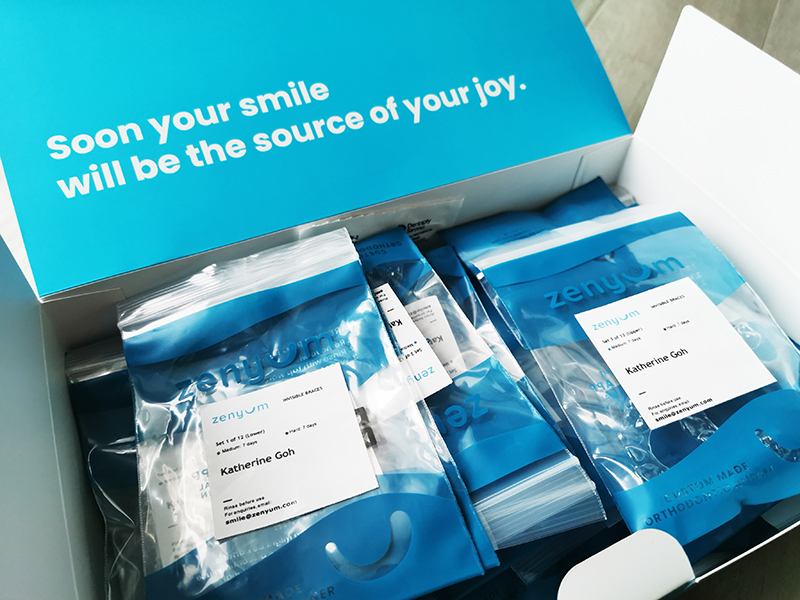
All my aligners are given to me at one shot.
The aligners for my whole treatment course were presented to me in a box. Each set was numbered in sequential order. I was to wear and switch to a new set every week. Previously when I was wearing metal braces, I had to make a monthly trip to the dentist to tighten my braces. But with Zenyum, I didn’t have to visit the dentist again until about ¾ into my treatment process.

A pair of Zenyum aligners that are part of my whole set.
I was amazed at how far technology has come since my teenage years. Zenyum makes use of an in-house app to help customers monitor their progress. The app also serves to send reminders to customers when it is time to switch to a new set of aligners. If I run into any issues with my aligners, I could also chat with the Zenyum customer care team through the app.
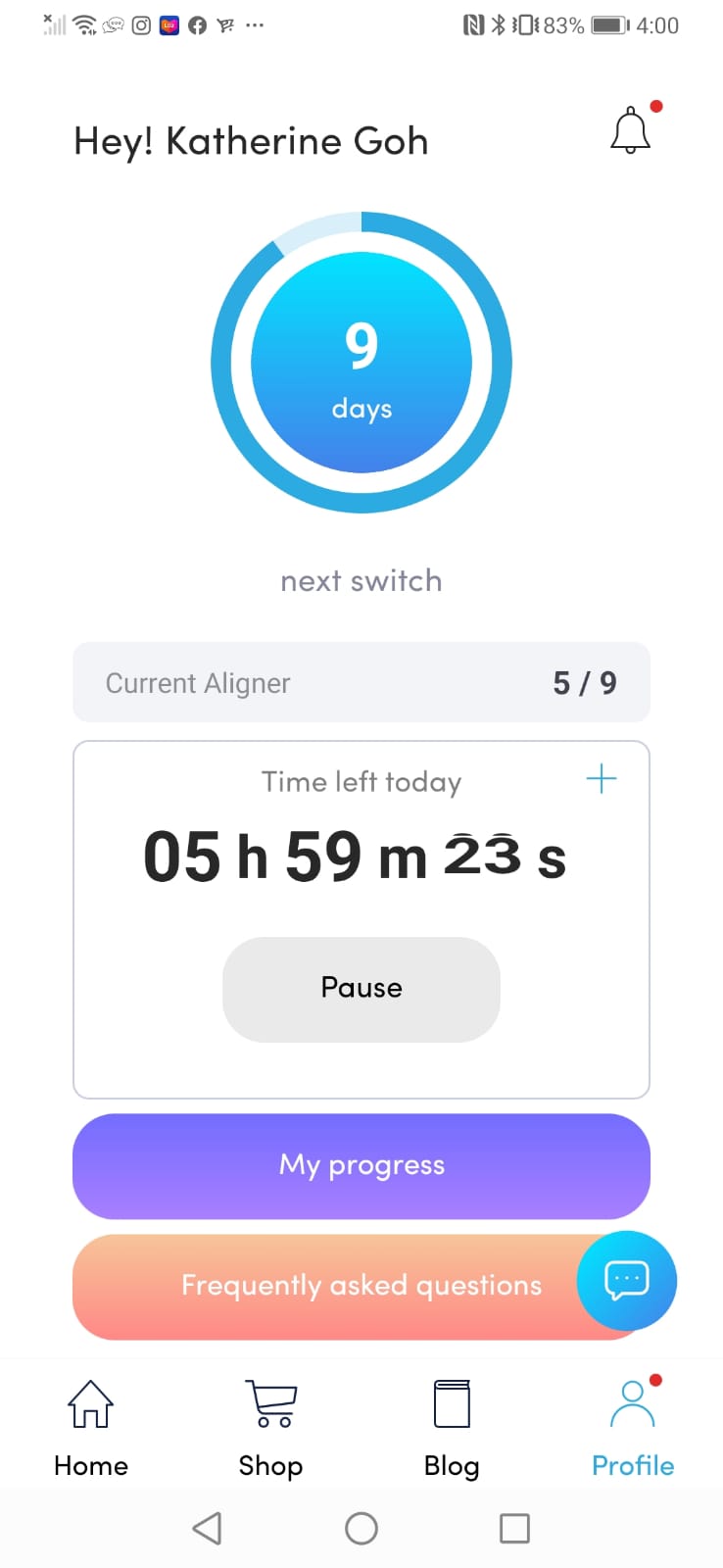
The Zenyum app allows customers to track their progress.
Wearing the aligners tend to be uncomfortable in the first day or so. But it was not unexpected, given my previous experience with metal braces. The teeth would be “forced” into a new position with every new set and naturally there would be tension felt. Personally, I didn’t have any issue with the discomfort; in fact, I looked forward to every single new switch of aligners because it meant a step closer to straight teeth.
The aligners have to be worn for 20 to 22 hours a day. The good thing about invisible aligners is I could remove them during meal times. Well, you wouldn’t be able to bite anything properly with the aligners on anyway.
All my concerns about the aligners being visible disappeared when I tried to show my “new teeth” to a friend. I wore my aligners and broke into a wide grin on purpose, and my friend still couldn’t see my aligners up close. (I did tell him I had aligners on.)
On the minus side, wearing the aligners does affect my speech somewhat. I find that I cannot pronounce the ‘s’ and ‘sh’ sounds properly. Having said that, not everyone would encounter the same problem as I do; a friend wearing aligners does not seem to have the same speech problems.
Approaching the End of the Road
My seven-month treatment got extended by a few months, partly because my dental review got delayed due to the lockdown. When my third dental review came, Dr Seow saw the need to refine my treatment further and a new treatment plan was done up for me at no extra cost.

My teeth before I began treatment (left) versus my teeth 12 months later (right).
I am now nearing the end of my treatment. Comparing with my previous experience of wearing metal braces, I feel that my Zenyum experience has been much more pleasant and less obtrusive. Wearing metal braces made me feel ugly and very self-conscious while with Zenyum aligners, my life went on as usual except for meal times.
On the topic of eating, I often had to deal with food getting stuck in my brackets with metal braces. I also could only eat “soft” food like porridge for the first few days following a tightening of my metal braces. With Zenyum aligners, I did not have to change my diet whatsoever and it was easy to remove my aligners for meals.

I am happy with my new smile now.
The biggest plus about Zenyum has to be the cost. Traditional braces cost upwards of S$4,000 and Invisalign cost S$8,000 or more. At S$2,400, Zenyum is definitely more accessible. Note that additional costs for the initial consultation (S$170) and retainers (S$300) are not included, though.
To be fair in my assessment, Zenyum is not perfect. I didn’t like the delays due to waiting during my treatment. My treatment got extended twice and with each new extension, I had to wait up to two months – from waiting for an appointment with the dentist to a new treatment plan to waiting for the new sets to arrive. If not for the waiting, my treatment duration could have been shorter.
I also feel that the Zenyum app could be simplified. The app has gone through a few different interfaces from the time I began treatment in January 2020 till now. The app was relatively straightforward to use initially but the current version is somewhat cluttered with too many features. However, the customer care staff are very helpful and friendly whenever I ran into problems.
Lastly, another downside of Zenyum is that it is not suitable for everyone. Zenyum can only treat those with mild or moderate cases of crooked teeth. In any case, the initial screening is free of charge so there is no harm in taking the first step by submitting your photos for assessment. I’d say, go for it.
If you are keen to find out if you are suitable for Zenyum, click here for more information.

